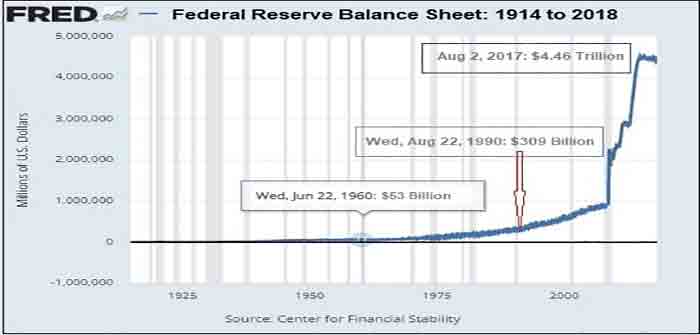
by Pam Martens and Russ Martens at Wall Street on Parade
Last month the Federal Reserve Bank of New York released its 2021 annual report from its “Markets Group.” That’s the group that operates a trading floor (complete with speed dials to the trading houses on Wall Street) at the New York Fed, located not far from the New York Stock Exchange, as well as another trading floor on the premises of the Chicago Fed, which is not far from the futures exchanges in Chicago. That report showed that despite all of the recent talk about the Fed dramatically shrinking its balance sheet from its current size of $8.9 trillion, the internal Federal Reserve plan for the balance sheet is actually this: “After declining by about $2.5 trillion from the peak size reached in the first half of 2022, the portfolio stops declining in mid-2025, at which point it is held constant at $5.9 trillion.” It is thereafter projected to start growing again in line with GDP. (See page 47 of the report at this link.)
The charts above show that the Federal Reserve was able to get through World War I, the Great Depression, World War II, the Vietnam War and the stagflation of the 1970s, without an explosion in its balance sheet. But since Ben Bernanke, Janet Yellen and Jerome Powell have, in turn, sat at the helm of the Federal Reserve, there has been unprecedented growth in the Fed’s Balance Sheet.
For example, from June 1960 to August 1990, the Fed’s balance sheet increased from $53 billion to $309 billion – an increase of 483 percent in 30 years. But during the tenures of Bernanke, Yellen and Powell, the Fed’s balance sheet has exploded from $880 billion in May 2008 to $8.9 trillion in May of 2022 – an increase of 911 percent in just 14 years.
There are a number of factors to explain this unprecedented growth in the Fed’s balance sheet. Chief among them are the following:
The Federal Reserve Board of Governors has outsourced its open market operations to the New York Fed, which is, literally, owned by a handful of Wall Street megabanks. (See related articles below.)
Congress has failed to separate…
Continue Reading